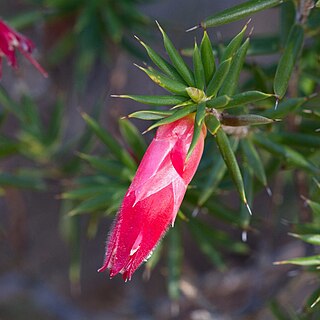
Stenanthera conostephioides, commonly known as flame heath, is a species of small shrub that is endemic to south-eastern continental Australia. It has linear to lance-shaped leaves, red, tubular flowers and green, oval fruit turning dark red.

Leucopogon pulchellus, commonly known as beard-heath, is a species of flowering plant in the family Ericaceae, and is endemic to the south west of Western Australia. It is an erect or straggling shrub with erect, linear leaves and short, dense spikes of white, tube-shaped flowers.

Styphelia planifolia is a species of flowering plant in the heath family Ericaceae and is endemic to the south-west of Western Australia. It is a bushy shrub with narrowly oblong or lance-shaped leaves with a small, sharp point on the tip, and white, tube-shaped flowers.

Leucopogon oldfieldii is a species of flowering plant in the heath family Ericaceae and is endemic to the south-west of Western Australia. It is an erect or spreading shrub with lance-shaped leaves and dense spikes of white or pink, tube-shaped flowers.
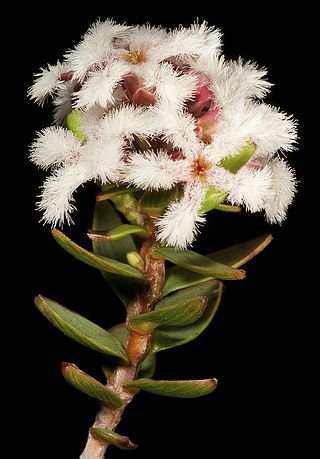
Leucopogon polymorphus is a species of flowering plant in the heath family Ericaceae and is endemic to near-coastal areas of south-western Western Australia. It is a shrub with egg-shaped to lance-shaped or almost linear leaves and short, dense spines of white, tube-shaped flowers.

Leucopogon bracteolaris is a species of flowering plant in the heath family Ericaceae and is endemic to the south-west of Western Australia. It is an erect shrub with egg-shaped to broadly lance-shaped leaves with the narrower end towards the base, about 4 mm (0.16 in) long. The leaves sometimes have a stem-clasping base, and are covered with fine hairs. The flowers are arranged in large, cylindrical spikes on the ends of branches with leaf-like, lance-shaped bracts and bracteoles almost as long as the sepals. The sepals are about 2 mm (0.079 in) long and lance-shaped, the petal tube is slightly longer than the sepals, and the petal lobes are longer than the petal tube.
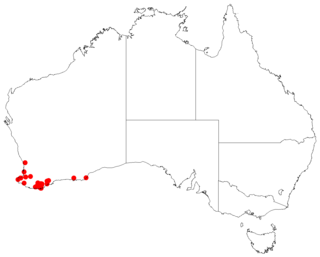
Leucopogon elatior is a species of flowering plant in the heath family Ericaceae and is endemic to the south-west of Western Australia. It is a slender, erect or straggly shrub with broadly egg-shaped leaves, and white, tube-shaped flowers.
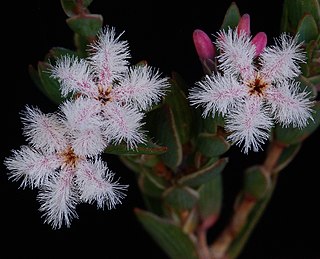
Leucopogon elegans is a species of flowering plant in the heath family Ericaceae and is endemic to the south-west of Western Australia. It is a spreading shrub with egg-shaped leaves, and white or pink, tube-shaped flowers densely bearded on the inside.

Leucopogon flavescens is a species of flowering plant in the heath family Ericaceae and is endemic to the south-west of Western Australia. It is a shrub with oblong leaves and white, tube-shaped flowers that are densely bearded on the inside.
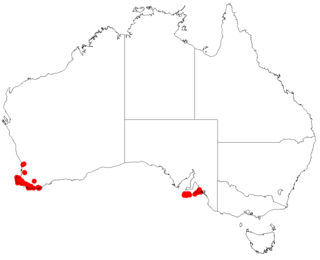
Leucopogon hirsutus is a species of flowering plant in the heath family Ericaceae and is endemic to southern continental Australia. It is a low-lying or straggling shrub with elliptic to oblong leaves and inconspicuous, white, bell-shaped flowers.

Conostephium preissii is a species of flowering plant in the family Ericaceae and is endemic to the southwest of Western Australia. It is an erect shrub with many stems, egg-shaped to oblong leaves and white and purplish to reddish-pink flowers.
Stenanthemum tridentatum is a species of flowering plant in the family Rhamnaceae and is endemic to the southwest of Western Australia. It is a prostrate to upright shrub with sparsely hairy young stems, egg-shaped to fan-shaped leaves, and creamy white or creamy-yellow flowers arranged singly or in groups of up to three.

Leucopogon obtusatus is a species of flowering plant in the heath family Ericaceae and is endemic to the south-west of Western Australia. It is an erect shrub that typically grows to a height of 0.25–1 m. Its leaves are sessile, egg-shaped to oblong, overlap each other and are about 2 mm (0.079 in) long. The flowers are arranged in short, dense spikes on the ends of branches or in upper leaf axils with leaf-like bracts and broad bracteoles less than half as long as the sepals. The sepals are about 2 mm (0.079 in) long, the petals about 4 mm (0.16 in) long and joined at the base, the lobes shorter than the petal tube.

Leucopogon oppositifolius is a species of flowering plant in the heath family Ericaceae and is endemic to the south of Western Australia. It is a slender, erect to spreading shrub that typically grows to a height of 15–80 cm (5.9–31.5 in). Its leaves are arranged in opposite pairs, narrowly linear to narrowly lance-shaped and 2–4 mm (0.079–0.157 in) long. The flowers are arranged in short spikes on the ends of branches with leaf-like bracts and narrow bracteoles about half as long as the sepals. The sepals are about 2 mm (0.079 in) long and lance-shaped, the petals about 4 mm (0.16 in) long and joined at the base, the lobes about the same length as the petal tube. Flowering mainly occurs from July to December.
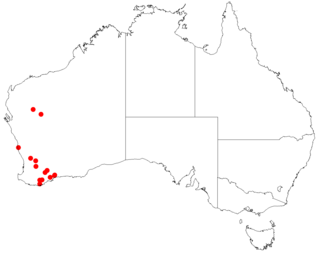
Leucopogon ovalifolius is a species of flowering plant in the heath family Ericaceae and is endemic to the south-west of Western Australia. It is an erect or straggling shrub that typically grows to a height of 1–2 ft (0.30–0.61 m). Its leaves are egg-shaped with the narrower end towards the base, 4.2–6.3 mm (0.17–0.25 in) long and sessile. The flowers are arranged in pairs or threes in leaf axils on a short peduncle with tiny bracts, and bracteoles less than half as long as the sepals. The sepals are about 2 mm (0.079 in) long, the petals 4.2–5.3 mm (0.17–0.21 in) long and joined at the base, the lobes longer than the petal tube.
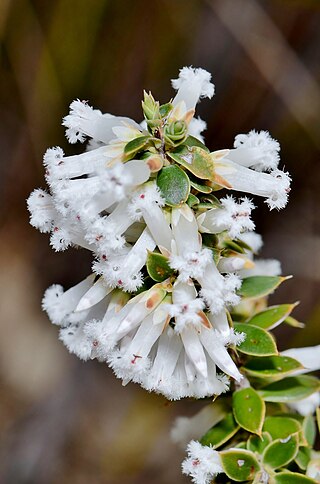
Leucopogon oxycedrus is a species of flowering plant in the heath family Ericaceae and is endemic to the south-west of Western Australia. It is an erect shrub with variably-shaped leaves with a small, sharp point on the tip, and white, pink or red, tube-shaped flowers.

Leucopogon reflexus, commonly known as heart-leaf beard-heath, is a species of flowering plant in the heath family Ericaceae and is endemic to the south-west of Western Australia. It is an erect shrub with small, usually downturned leaves and short, dense spikes of tube-shaped, white flowers.
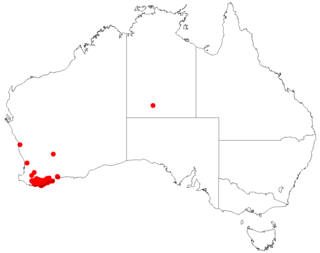
Leucopogon tamariscinus is a species of flowering plant in the heath family Ericaceae and is endemic to the south of Western Australia. It is an erect shrub with egg-shaped or lance-shaped leaves and white, tube-shaped flowers arranged in dense spikes on the ends of branches.

Leucopogon tenuicaulis is a species of flowering plant in the heath family Ericaceae and is endemic to the far southwest of Western Australia. It is an erect or sprawling shrub with thin stems, upright triangular to narrowly egg-shaped or narrowly elliptic leaves and erect, white or pale pink, tube-shaped flower arranged in large groups on the ends of branches and in upper leaf axils.

Leucopogon tetragonus is a species of flowering plant in the family Ericaceae, and is endemic to the south of Western Australia. It is a robust shrub with crowded, often decussate, oblong to lance-shaped leaves and short, dense spikes of white, tube-shaped flowers.




















